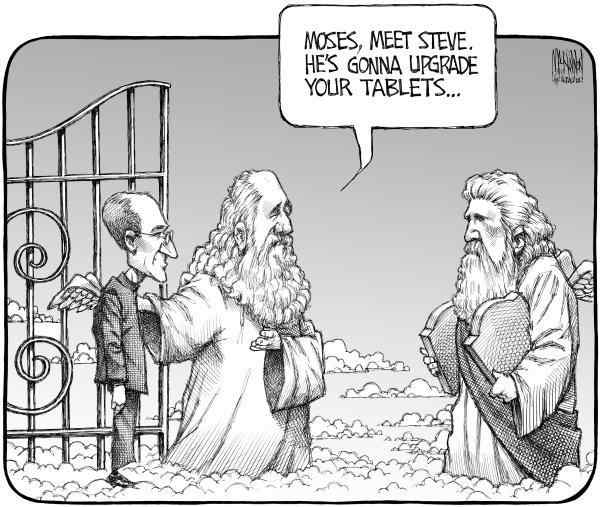Gazing Forward, Glancing Back: Connecting the i-dots!
By critical acclaim, Steve Jobs is considered to be a creative genius and a great visionary leader. More than one pundit, praising Steve’s ability to transform industries with his inventions, have called him a modern-day Leonardo da Vinci.[1] He wanted to leave his permanent mark on the universe: “We’re here to put a dent in the universe,”[2] And what a mark he did leave, if influence is any measure of a man.
“I like living at the intersection of the humanities and technology,” Steve Jobs once said. When introducing the iPad 2, Jobs summarized his strategy this way: “It is in Apple’s DNA that technology alone is not enough—it’s technology married with liberal arts, married with the humanities, that yields us the results that make our heart sing.”[3] It was a chance dropping in a class about Chinese calligraphy that primed the future leader of Apple with added sense of aesthetics and which to this day makes the hearts of Apple customers sing.
With the passing of Steve Jobs, one cartoon (used as a featured image for this post) stood out: St. Peter introduces Jobs to Moses with the caption: “Moses, meet Steve. He’s gonna upgrade your tablets.”[4] As below, so above!
Many believe that the inner clarity and conviction that Steve Jobs attained was the result of his deep explorations into his spiritual self. It is well known that Steve was mystified by Eastern philosophies. He went to India during the ‘70s as teenager before he co-founded Apple. It proved to be a life changing experience and a great turning point in the real spiritual sense.
After reading Harvard professor Ram Das’s Be Here Now and Paramahansa Yogananda’s Autobiography of a Yogi, Steve Jobs traveled to India in 1974 with a friend, Dan Kottke, who later became Apple’s first employee. His trip to India was disappointing and revelatory at once, as he himself realized and recounted: “We weren’t going to find a place where we could go for a month to be enlightened.”[5] Yet in a far more important sense, during his short fling into various Indian āshrams, Steve picked up the importance of cultivating inner centeredness and composure and looking at the world from the inside out. This orientation seemed to have served him well throughout his life as a leader of Apple.
Steve’s India connection, though, preceded his trip. As a penniless college drop-out, he would walk seven miles every Sunday to get a free meal at the Hare Krishna temple. He also retained a lifelong admiration for Mahatma Gandhi. In 1997, Apple’s ‘Think Different’ ads, which featured his personal idols, included the Mahatma.[6]
His interest in Eastern spirituality was solidified later when he dabbled into Zen Buddhism at the Los Altos Zendo. The greatest influence on Steve Jobs, however, was the book Autobiography of a Yogi— “the guide to meditation and spirituality that he had first read as a teenager,” his biographer, Walter Isaacson, tells us, “then re-read in India and had read once a year ever since.” It was the only book, Isaacson notes, that Steve downloaded on his personal ipad2.[7] Steve’s credo “Actualize yourself” seems to have come directly out of Yogananda’s philosophy of Self-realization.
It has recently come to knowledge that copies of Yogananda’s classic autobiography were handed out at Steve Jobs’s memorial, as reported by Marc Benioff, CEO and Co-Founder of Salesforce.Com, in a Tech Crunch Disrupt SF 2013 conference interview.[8] Marc shares his story of opening the brown box that was given to every guest at Steve Job’s memorial service. Steve Jobs had apparently arranged to gift Yogananda’s Autobiography of a Yogi in his own memorial service as a last gift to the attendees![9]
Paramahansa Yogananda was the first great spiritual master of India to live in the West for a long period (over thirty years). In what may be described as the most intimate firsthand account of a master’s spiritual unfoldment, Yogananda, in his Autobiography, memorably chronicles his encounters with many saints and sages during his youthful search throughout India for an illumined teacher; ten years of training in the hermitage of a revered yoga master; and the thirty years that he lived and taught in America. It also records his meetings with Mahatma Gandhi, Nobel Laureate Rabindranath Tagore, Luther Burbank, and other celebrated spiritual personalities of East and West.
The Columbia University Press review extolled Autobiography of a Yogi in these glowing terms: “There has been nothing before, written in English or in any other European language, like this presentation of Yoga.”[10]
Hailed as ‘a book about yogis by a yogi,’[11] it is indeed a rare marvel of self-mastery through mind-control and self-realization. Here is an illustration of the great power of love and of the mind over matter, narrated in the inimitable style by Yogananda in this book:
“The secret of improved plant breeding, apart from scientific knowledge, is love.” Luther Burbank uttered this wisdom as I walked beside him in his Santa Rosa garden. We halted near a bed of edible cacti.
“While I was conducting experiments to make ‘spineless’ cacti,” he continued, “I often talked to the plants to create a vibration of love. ‘You have nothing to fear,’ I would tell them. ‘You don’t need your defensive thorns. I will protect you. Gradually the useful plant of the desert emerged in a thornless variety.”[12]
Steve Jobs learned some important lessons from the book: the importance of holy curiosity and sense of wonder,[13] self-effort, self-realization and, above all, fearlessness in facing life and death. Jobs, who in his 2005 Stanford Commencement Speech memorably described death as “very likely the single best invention of life,”[14] departed from this world exclaiming: “Oh wow. Oh wow. Oh wow.”[15] In the same speech, signaling the importance of loving what we do, he noted, “Your work is going to fill a large part of your life, and the only way to be truly satisfied is to do what you believe is great work. And the only way to do great work is to love what you do.”[16]
In this seminal Commencement address, Steve told three remarkable stories. His first story was about connecting the dots looking backward.[17] He recounted his struggles in early life, including the touching story about his adoption. The second story was about his rise, fall, and rise again with Apple. The crux of the speech, and its most compelling part, came in the third story which describes his bout with cancer.
“My third story is about death,” Steve Jobs continues:
When I was 17, I read a quote that went something like: “If you live each day as if it was your last, someday you’ll most certainly be right.” It made an impression on me, and since then, for the past 33 years, I have looked in the mirror every morning and asked myself: “If today were the last day of my life, would I want to do what I am about to do today?” And whenever the answer has been “No” for too many days in a row, I know I need to change something.[18]
Perhaps certain things become clearer with the impending inevitability of death. The day before Steve Jobs passed away, he told his sister, Mona Simpson, that he was going to a better place.[19] Steve’s sister reminisced in the eulogy she delivered at his memorial service: “Death didn’t happen to Steve, he achieved it.”[20]
Steve seems to have made his peace with the universe, finally.
Reflecting on the cartoon that we referred to in the opening of this entry, Nick Gier, quips: ‘If there is a heaven then Steve Jobs has not only met St. Peter and Moses, but he is also been pitching his great ideas among all the saints of human history. They will learn a lot from him, and perhaps they will teach him a little humility.’[21]
Perhaps, nature does not like to give two gifts to one person. If flair for novelty was Steve Jobs’ greatest gift, it certainly did not come wrapped in the gentle cloak of humility. Nevertheless, his constant effort to remake himself, to self-actualize his total potential, does seem to point to an unremitting commitment to spiritual quest—the hallmark of all good and great leaders.
Endnotes:
[1] Brandon Griggs, Steve Jobs praised as Apple’s visionary, creative genius, CNN. October 6, 2011. Retrieved August 21, 2015: http://www.cnn.com/2011/10/06/us/obit-steve-jobs/
[2] John D. Sutter, “5 memorable quotes from Steve Jobs.” CNN. Retrieved August 21, 2015:
http://www.cnn.com/2011/10/05/tech/innovation/steve-jobs-quotes/
Walter Isaacson, biographer of Steve Jobs, titles chapter fifteen in Steve’s biography as “A Dent in the Universe.” This expression occurs at least 6 times in this biography. See: Walter Isaacson, Steve Jobs (New York: Simon & Schuster, 2011), 92, 94, 112, 159, 490, and 499.
[3] Jonah Lehrer, Steve Jobs: “Technology Alone Is Not Enough.” The New Yorker. October 7, 2011. Retrieved August 22, 2015: http://www.newyorker.com/news/news-desk/steve-jobs-technology-alone-is-not-enough
[4] Moses Meet Steve, He’s Gonna Upgrade Your Tablets. A Cartoon, posted October 10, 2011. Retrieved August 21, 2015: http://weknowmemes.com/2011/10/moses-meet-steve-hes-gonna-upgrade-your-tablets/
[5] Anthony Imbimbo, Steve Jobs: The Brilliant Mind Behind Apple (Life Portraits) (New York: Gareth Stevens Publishing, 2009), 42.
[6] Trip to India as teen was a life-changer for Steve Jobs. The Economic Times. Retrieved August 21, 2015: http://articles.economictimes.indiatimes.com/2011-10-07/news/30253986_1_steve-jobs-story-of-apple-computer-steve-wozniak
Steve also alludes to his Sunday free meals at Hare Krishna temple during his 2005 Stanford speech.
[7] Walter Isaacson, Steve Jobs (New York: Simon & Schuster, 2011), 527.
[8] Marc Benioff on the Invisible Hand of Steve Jobs | Disrupt SF 2013. Interview Retrieved August 22, 2015 https://www.youtube.com/watch?v=4rO_Vs4M29k
[9] Walter Isaacson in his biography, Steve Jobs, lists a number of books that influenced Steve Jobs: William Shakespeare’s King Lear, Plato, Clayton Christensen’s Innovator’s Dilemma, Shunryu Suzuki’s Zen Mind, Beginner’s Mind, Chogyam Trungpa’s Cutting Through Spiritual Materialism, Paramahansa Yogananda’s Autobiography of a Yogi, and Herman Melville’s Moby Dick. See: Isaacson, Steve Jobs, p. 35.
[10] See reviews published on the back cover of 1972 edition of Autobiography of a Yogi.
[11] W.Y. Evans Wentz, Op. cit., in a Preface to Paramahansa Yogananda, Autobiography of a Yogi (Los Angeles, CA.: Self-Realization Fellowship, 1972), vii.
[12] Ibid., 411.
[13] One thinks here of Carlyle’s observation in Sartor Resartus: “The man who cannot wonder, who does not habitually wonder (and worship), were he president of innumerable Royal Societies and carried . . . the epitome of all laboratories and observatories, with their results, in his single head,-is but a pair of spectacles behind which there is no eye.” Cited in Autobiography of a Yogi, p. 384. Autobiography is full of such soul-uplifting insights.
[14] Steve Jobs’ 2005 Stanford Commencement Address. Retrieved August 22, 2015: https://www.youtube.com/watch?v=UF8uR6Z6KLc
[15] Sam Jones, Steve Jobs’s last words: ‘Oh wow. Oh wow. Oh wow.’ The Guardian. October 31, 2011. Retrieved August 22, 2015: http://www.theguardian.com/technology/2011/oct/31/steve-jobs-last-words
Legend has it that, at his death in 1951, Ludwig Wittgenstein’s last words were “Tell them I’ve had a wonderful life.” See: Ray Monk, Ludwig Wittgenstein: The Duty of Genius (New York: Macmillan, 1990), 579.
[16] Steve Jobs’ 2005 Stanford Commencement Address.
[17] Perhaps the Danish philosopher, Søren Kierkegaard, expressed the sentiment more accurately: “Life can only be understood backwards; but it must be lived forwards.”
[18] Ibid.
[19] Mona Simpson, A Sister’s Eulogy for Steve Jobs. The New York Times. October 30, 2012. Retrieved August 21, 2015: http://www.nytimes.com/2011/10/30/opinion/mona-simpsons-eulogy-for-steve-jobs.html?pagewanted=all&_r=0
[20] Ibid. Emphasis added.
[21] Death as a Friend for Jobs, Mozart, and Don Juan. A Blog Post by Nick Gier, posted on November 29, 2011. Retrieved August 22, 2015: http://www.pocatelloshops.com/new_blogs/politics/?p=8562


Excellent writing Prof. Dhiman..